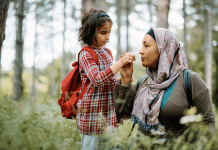April marks Sexual Abuse Awareness Month and an opportune time to have a sit down with your child. As a parent, you know we all feel a little hesitation when deciding how to have the conversation. Yes, having THE TALK. You know, the discussion with our little ones about their bodies, how they work, the need to keep some parts private; and the how-to, as it relates to safety. Deciding the appropriate time to have the talk and the depth of the details can be a brain buster. But equipping your children with the knowledge to protect themselves and to find comfort in being vulnerable with you is priceless.
Sexual abuse can occur in children of all races, socio-economic groups, cultures, and religions. It has an ugly way of rearing itself in all communities. No one is immune. Although disheartening, this truth should compel each of us to take any and all preventative measures. While indeed stressful, having open dialogue with your children frequently can help them identify a threat and build courage to express themselves to you, if need be. So, what can you as a parent do to begin the conversation?
Talk early about body parts.
Get comfortable naming all body parts and reduce the shame surrounding certain areas. Use proper nouns for body parts and/or teach your child the actual words for each part. They should feel as relaxed talking to you about their bottom as they do their arm. Using these words comfortably and appropriately will help your child speak clearly in any event that may arise.
Discuss the reason for privacy surrounding certain parts.
Specify private areas and explain to your child that they are called private because everyone cannot and should not see them. I’ve always told my kids that moms and dads can see their children naked, but anyone outside of parents should only see them fully clothed. I would even go a step further and explain that doctors may on occasion need to examine them, but that is always in the company of mom or dad. This gives them a sense of security and trust knowing they can depend on their parents to keep them safe.
Notice red flags.
Child sexual abuse affects 1 in 20 boys and 1 in 4 girls. Every April is considered Sexual Assault Awareness Month (SAAM). Its purpose is to raise awareness and prevent sexual violence through special events and public education. It happens more often than most people believe. The average number of victims of rape and sexual assault is 207,754 (aged 12+) each year.
However, 90% of children who have been sexually abused know the abuser. Parents tend to think of creepy strangers as abusers, however this is not true. It could be anyone and happen anywhere. The goal is to teach your children to practice safe behaviors at all times. This includes interactions with friends, family, and especially when using online platforms. Abusers often use technology as a tool to build trust with children who are vulnerable to compliments and attention.
Some warning signs that parents should be aware of include changed behavior, withdrawal from family life, and an outburst of anger and/or nightmares. However, there are times when signs can be missed or even displayed. Just remember to be as present and open to listen when they come to you with news to share.
Use your listening ears.
If your child comes to you with something that they think is essential, take the time to hear it. Always show them your utmost care and let them know that you take their thoughts and/or concerns seriously. If they know you listen openly, they are more likely to come to you in the future. Create a comfy environment for honesty and courage.
Young children are often afraid to get into trouble or offend their parents by asking questions or talking about their experiences. Please remind your child that your ears are a safe place to share information, and you will not punish them for sharing this information with you.
Use media to increase relevance.
Children are very technologically saavy. Ask your child what’s happening on social media, news, new movies, or popular TV shows. You can also watch episodes with them and ask follow-up questions. Listening to them shows them that you are grateful for their perspective and opens the door to further conversations. It is essential to create a dialogue with your child on topics such as sexual assault and safety. Never be apprehensive about equipping them with tools to create safe boundaries for themselves.
Use Your Experience to Talk about Safety.
Lastly, sharing your experience can make these conversations relevant and look more realistic to children. If you don’t have an easy-to-share experience, you can talk to someone you know. The National Sexual Assault Hotline is available 24/7. They can be reached via phone at 1.800.655.HOPE or via online chat at online.rainn.org.












